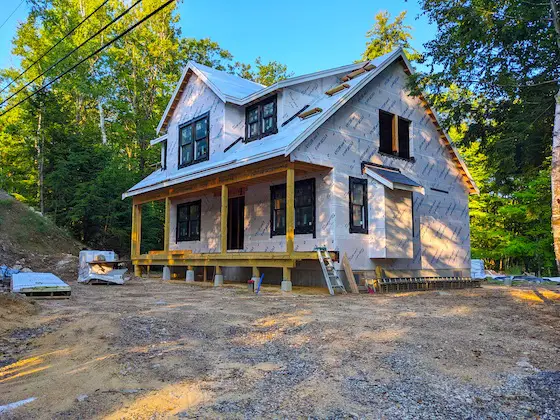New Home Budget

New Home Budget | This new home should have been finished a month ago. If things continue to creep along, my guess is the owners will move in about ten months from now. Copyright 2023 Tim Carter
How to Create a Realistic New Home Building Budget
Are you thinking of building a new home or doing a major remodeling project? If so, I’ve got some sobering news for you. After reading this column you may understand why the moniker my three kids coined for me years ago is spot on. Around the Carter house, I’m known as the Dream Crusher.
First things first. Your new home or remodeling job will happen. The issue is how long will it take for your dreams to come true and at what cost? I’m all about setting realistic goals and managing expectations. I’m going to do my best to ensure you’re not about to embark on a voyage that will lead to financial disaster or have you dashed upon hidden shoals of contractors and subcontractors who suffer from time blindness.
I receive emails each week via my www.AsktheBuilder.com website detailing all sorts of horror stories about building projects that have run off the rails. The trend is increasing, not decreasing. My own daughter just a few years ago was a victim. She built a new house with excellent plans on Mt. Desert Island in Downeast Maine.
My Daughter's New Home
It was a simple rectangular house with an attached garage. In my prime, I would have completed the job on time in about seven months. There would have been no cost overruns. From the time the lot was cleared until the day she moved in, twenty-two months had passed. The project came in $100,000 over budget.
A neighbor of mine just two houses away started a major remodeling job ten months ago. The roof of their garage was demolished to create a second-story one-bedroom apartment. A small addition was added on the first floor to create a bigger kitchen.
I had done quite a few similar jobs just like this years ago. Had I taken longer than four months to complete each one, I’d have gone bankrupt. The dumpster is still in her driveway, a sub-contractor’s trailer is still parked on my street, and I estimate the job will not be finished for months. I can’t tell you how much the job is over budget but my guess is inflation alone is creating a 20 percent overage.
Prevent Financial Stress
Here’s what I would do if I were you. Let’s start with preventing a financial time bomb. It’s mission-critical you are not financially stressed or face the prospect of running out of money sitting with a partially finished project.
How to Create a Realistic Budget
Step one is to create a realistic budget. This requires basic math skills. If you own your own home meet with the top three realtors and discover what your house might sell for. Determine what equity you’ll have after the house would sell. Add this amount to the construction loan you’ve been pre-approved for. This is your not-to-exceed number. Your contract sum with a builder should be approximately 80 percent of this number. This provides for a reasonable amount of dry powder to cover cost overruns.
Step two is to meet with two or three builders. Ask them to show you one or two recently completed houses that are similar to what you want. Have them tell you what the final finished price was. Ask for a set of plans so you can do the math to see what the actual cost per square foot was.
Divide your not-to-exceed number by the square-foot cost average. This tells you how big your new home can be. Will you have enough square footage? Don’t forget to factor in the cost of plans, the purchase price of the land, etc. If after doing this you feel you can move ahead, now is the time to draw plans.
You must have excellent plans and specifications before you go out to bid. All products should be specified on the plans. There should be no allowances. Once you have the green light for the project, purchase as many of the materials and products as you can early in the job. My daughter rented a storage space to store all the cabinets, light and plumbing fixtures, windows, doors, etc. Doing this prevents price increase surprises.
If you’re doing a major remodel, most of the above advice applies to you. To be on the safe side, I’d allow for cost overruns in the 25 to 35-percent range. Who knows what surprises lurk behind your existing walls?
The national labor shortage in many trades is the primary reason jobs are taking longer to complete. This issue is much worse in some cities than others. Add to this the mismanagement of resources by contractors who have never taken a business class in their lives and it’s a recipe for disappointment.
Prepare yourself for delays, countless excuses, and frustration. Think about taking up yoga or deep meditation to help manage any stress you’ll undoubtedly encounter. I wish you the best of luck and realize I do phone construction consulting should you need help.
Column 1518